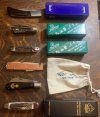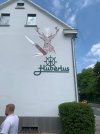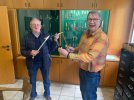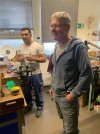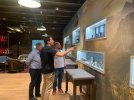Just discovered this thread today and have enjoyed going through it very much! In Spring 2022, I had the rare opportunity to spend half a day in Solingen. We were attending the wedding of our former exchange student in his hometown of Borken, which is about an hour and 15 minutes north.
Our “German son’s” real parents knew that I liked pocketknives and beer and the itinerary thy planned did not disappoint! I posted some of the info below in a FB group right after the trip.
One morning a day before the wedding, the men headed for Soligen and the women headed for Cologne. While in Solingen, we visited knife-makers Hubertus, Otter, and Puma.
We began by spending time with Henning Ritter of Hubertus, who is a walking encyclopedia of knowledge about the history of the Solingen cutlery industry. The Ritters are the third generation family owners and they had recently retired from active production, after helping their cutlers find positions with other knifemakers - with Otter taking over the production of at least part of their their line, especially their classy lever switchblades, which are known as “springers.” I ended up purchasing a stag springer with a Damascus clip blade and a stag two-blade barlow with a corkscrew (a common implement on German knives). The barlow was apparently from older stock, with W. Germany etched on the blade.
At Otter, a company with which I was totally unfamiliar, Frank Rommel took time to give the four of us a personal tour. Otter is a relatively small operation with the family “feel” and high quality of workmanship that remind me of GEC. They own the Mercator brand, currently mostly known in the USA for their K55K (can’t make that second K backwards) “black cat” knives, which are know offered in a variety of handle materials at really bargain prices. The groom and I each purchased a copper-handled, stainless Mercator with a single spear blade. I couldn’t resist also getting a single blade navy knife in granadillo wood covers with a brass anchor shield. The latter knife I had seen in the Garrett & Wade tool catalog, but I had no idea that it was made by a company called Otter. They also make other knife lines that are featured on the photo of their van below.
We ended the day by visiting Puma, arriving after the factory had closed for the day. The brand is special to me because my first major knife purchase (on a layaway plan) was a Puma White Hunter in 1974 at the Woolco in Bowling Green, KY. That was the big stag knife that a couple of scouts in my troop carried - that or the Puma Skinner model. Back then, scouts were still allowed to carry fixed blade knives. It cost $25.00 plus tax of my paper route money and I still have the knife. Although the factory was closed, the busy office was still open. They, like Boker, which apparently wasn’t open on that Monday, now have knives made all over the world, with their German-made models costing quite a bit. I ended up purchasing a German-made cigar pattern stag knife with two blades and a corkscrew. Puma has a nice sales display and a small museum featuring older knives that we checked out on our visit.
Below is a photo of the knife my hosts gave me, the knives purchased in Solingen, as well as photos from the three manufacturers we visited, which each begin with a photo that lets you know where the photos were taken. My collection is almost exclusively American-made knives, but I could not resist getting some of those German beauties!
And the wedding, held at a local castle no less, was a blast! The day after, Labor Day, continued the party, with plenty of regional beers to consume while about 20 of us rode in a special trailer with a giant central ice trough, which was pulled by a big John Deere. This was our first trip to Europe and our German hosts were fabulous!!
